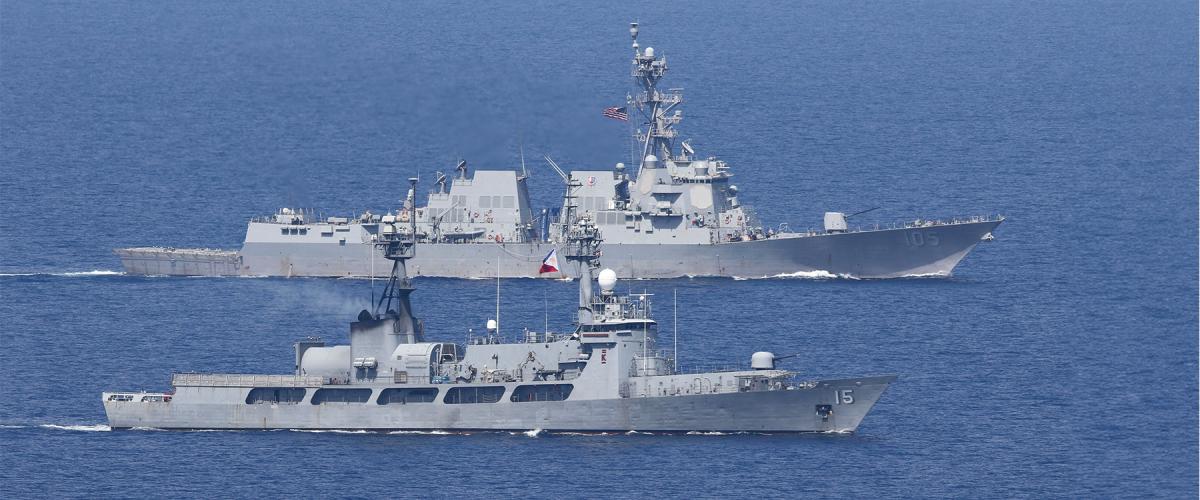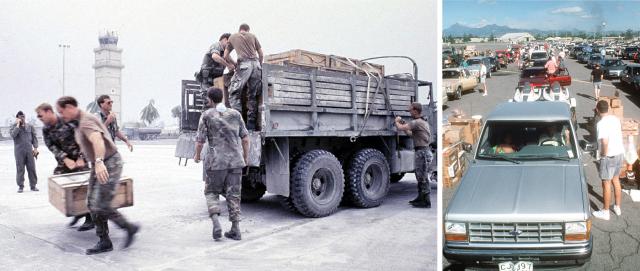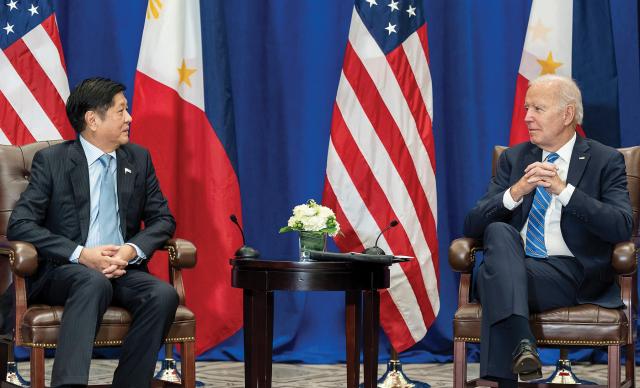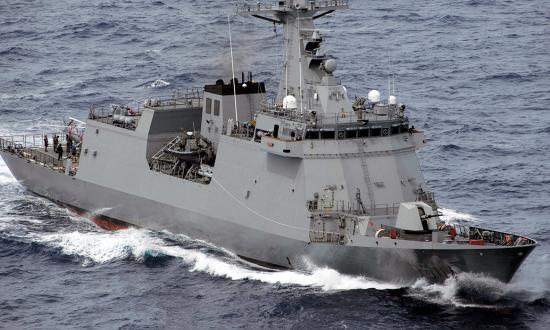Partnership with the Philippines remains vital for the U.S. Indo-Pacific strategy. Because of its geographic location as a southern anchor of the first island chain and eastern rim of the South China Sea and as a geographic link between Japan and Australia, the Philippines is second only to Japan in strategic importance for that region. Furthermore, because of the deep historical U.S.-Philippine association and close personal ties, the security and prosperity of the Philippines is important to U.S. national prestige and credibility as a global power. This history, however, is fraught with controversy over U.S. military bases.
Locating U.S. military bases in allied nations depends primarily on two factors: 1) a shared sense of threat, and 2) a consolidated ruling government that has the legitimacy to conclude and enforce basing agreements. So long as these two factors remain, U.S. military bases are secure. But when the sense of threat diminishes or the ruling regime that supports the bases becomes weak or collapses, the presence of U.S. military bases can become politicized and their future put in doubt. Such has been the history of U.S. bases in the Philippines.
The Cold War Alliance and Military Bases
During the Cold War, the U.S.-Philippine security relationship progressed through three phases that corresponded with the changing threat perceptions of each partner.
When the Philippines became an independent nation in 1946, it still depended on U.S. forces for its external security. Although the United States had excluded its bases from the transfer of sovereignty under the 1946 Treaty of General Relations, both the Secretary of War and U.S. Army Chief of Staff recommended a complete pullout of U.S. forces as part of postwar demobilization.1 Fearing a mass pullout of forces it still depended on for protection, the Philippine government lobbied for a basing agreement to retain a U.S. military presence.2 The United States used this desire to negotiate an extremely favorable agreement—the 1947 Military Bases Agreement (MBA)—that provided the United States full sovereignty and unrestricted use of 16 bases, with an option for 7 additional bases, for up to 99 years.3
Once the Cold War turned hot in Korea and communist insurgency spread throughout Southeast Asia, the Philippine bases became essential to both nations’ security interests. This shared sense of threat from within and without formed the basis for the United States’ first formal treaty alliance in East Asia. In 1951, the United States and the Philippines signed a Mutual Defense Treaty (MDT).4 From that point until the late 1950s, the U.S.-Philippine alliance enjoyed a golden era of security cooperation. U.S. forces provided external security while the Armed Forces of the Philippines (AFP) ensured internal security against communist insurgents.5
As the Cold War progressed throughout the late 1950s and into the 1960s, however, the allies’ respective threat perceptions diverged. For the United States, the Philippines remained the southern anchor of its offshore defensive perimeter in East Asia. Yet, Philippine officials did not perceive a threat to their sovereignty once they suppressed the communist insurgency.
This imbalance gave the Philippine government leverage in renegotiating the MBA on more favorable terms. Consequently, the two allies conducted a series of renegotiations to lessen the MBA’s neocolonial aspects. Significantly, in 1966, the United States and the Philippines negotiated an amendment that revised its terms to “a period of 25 years from September 16, 1966.”6 Absent any formal agreement to extend the MBA, it would expire in 1991.
The People Power Revolution
No national leader has been more successful in manipulating base politics to serve their own domestic political interests than Ferdinand Marcos. Marcos engaged in a psychological warfare campaign by encouraging open demonstrations of nationalist antibase sentiment within his own government. He also cozied up to communist and nonaligned leaders in the region to enhance U.S. fears of losing the bases if it did not provide concessions and bolster its support of his corrupt regime.7 U.S. officials became convinced Marcos was the only one who could protect their bases and therefore must be kept in power.8 Because of firm U.S. support throughout Marcos’ 20-year rule, his regime became known by its opponents as the “U.S.-Marcos Dictatorship.”9
Following the assassination of Marcos’s political rival in 1983, however, the Marcos regime began to collapse, culminating in the 1986 People Power Revolution, which replaced Marcos with a nascent democracy. Because U.S. policy in the Philippines was closely associated with the former dictatorship, the future of the bases was in jeopardy. The Philippine Senate would have to approve a new base agreement once the MBA expired in 1991.
Although democracy returned to the Philippines, it was far from stable. This period became known as the “Season of Coups,” and it lingered more than a decade.10 Such was the domestic political environment in which the negotiations for a new base agreement were conducted, but a declining threat also undermined the agreement’s rationale.
The Diminishing Regional Threat
Because of the growing Soviet naval presence in Southeast Asia throughout the 1980s, the Philippine bases were of immense importance to the U.S. containment strategy. In 1979, the Soviet Union began deploying its naval and air forces to Cam Ranh Bay in Vietnam.11 Throughout the 1980s, Cam Ranh Bay hosted the largest concentration of Soviet forces outside the Warsaw Pact.12
But with the fall of the Soviet Union and end of the Cold War, this threat evaporated. Beginning in 1989, the Soviets began to curtail deployments to Cam Ranh Bay. By late 1991, very few Soviet forces remained.13 This undermined the rationale for maintaining such a large U.S. military presence in the Philippines. Moreover, negotiations for a new base agreement had begun in September 1990 as the Soviet Union was collapsing. They continued for 11 months as the Soviet threat all but vanished, which, combined with the volatility of Philippine politics, undermined the future of the U.S. bases.
Base Negotiations and Senate Rejection
Because of the diminishing regional threat and because Philippine democracy was still unstable, the negotiations were contentious and fraught with controversy. Moreover, the association of previous base agreements with the Marcos regime delegitimized them.
From the Philippine perspective, the base negotiations were merely a “commercial transaction.”14 Mutual security interests were almost nonexistent. For the United States, negotiators wondered if the exorbitant costs and operating restrictions were worth whatever security benefits the bases would provide.15 An already bad situation, however, soon became worse.
Just as negotiations were about to conclude, two natural disasters destroyed Clark Air Base. In June 1991, Mt. Pinatubo erupted—the second largest volcanic eruption of the 20th century. During the eruption’s peak, Typhoon Yunya swept across southern Luzon, passing near the volcano. Torrential rain mixed with the ash cloud and “descended like wet concrete.”16 The U.S. military evacuated more than 18,000 U.S. citizens from the area, the largest military evacuation since the fall of South Vietnam. Shortly thereafter, on 17 July, the United States announced that Clark Air Base would not reopen.17
Following this disaster, the negotiators quickly came to an agreement. Yet, on the exact day that the MBA expired, 16 September 1991, the Philippine Senate rejected the new agreement. The senators who rejected it did so while invoking grandiose nationalist sentiments.18 After some controversy over when to evict U.S. forces, the United States agreed to withdraw by the end of 1992.
Withdrawal
The withdrawal of U.S. forces from the Philippines was a massive undertaking. Throughout the 1980s, there were approximately 15,000 troops stationed in the Philippines. By September 1991, following the evacuation and closure of Clark Air Base, that number had decreased to 7,761.19 Finally, on 24 November 1992, only 28 members of the Joint Military Assistance Group, Philippines, remained, attached to the U.S. embassy in Manila.20
U.S. military strategists sought to broaden their engagement in Southeast Asia and develop alternative security cooperation partnerships. U.S. Pacific Command developed a strategic concept of “places, not bases” to focus on access to strategic locations and facilities in the region rather than establishing a permanent military presence.21 Prime Minister Lee Kuan Yew of Singapore, concerned China would dominate Southeast Asia if the United States departed the region, offered Singapore’s naval berthing and repair facilities as an alternative to Subic Bay.22 The U.S. Navy took him up on this offer. The remaining forces redeployed throughout the Pacific Command area of responsibility.
A New Challenge Arises in the South China Sea
The departure of U.S. forces from the Philippines created a power vacuum in Southeast Asia that China would soon fill. In 1992, as U.S. forces were withdrawing from the Philippines, China enacted the Law of Territorial Waters and Contiguous Land Claims, which proclaimed jurisdiction over most of the South China Sea.23 China made its first major move to assert its claims in 1995 by seizing Mischief Reef, which is inside the Philippines’s exclusive economic zone (EEZ). Suddenly, the Philippines’ perception of an external threat increased.
For the United States, the 1996 Taiwan Strait Crisis was a catalyst for increased concern about China’s ambitions.24 Since then, the United States also has become increasingly concerned about a threat to freedom of navigation in the South China Sea. For the first time in four decades, the United States and the Philippines were developing a shared sense of threat from a rapidly growing and assertive regional power.
Revitalization of the Alliance
There were three main factors in revitalizing the U.S.-Philippine alliance: geography, a shared threat perception, and the consolidation of democratic rule in the Philippines. These factors combined during the first two decades of the 21st century to foster a renaissance in U.S.-Philippine security cooperation.
Geographically, the Philippines is highly vulnerable to Chinese claims in the South China Sea. The Philippine archipelago forms the eastern rim of the South China Sea, and China’s maritime claims overlap a substantial portion of the Philippines’ EEZ. Indeed, China poses a greater threat to Philippine sovereignty than the Soviet Union ever posed during the Cold War.
China’s growing assertiveness threatens the interests of both the United States and the Philippines. This shared sense of threat was the impetus for revitalizing the alliance. In 1996, the two governments began negotiating a status of forces agreement, which resulted in the 1998 Visiting Forces Agreement (VFA).25 The VFA allowed the temporary rotational presence of U.S. forces in the Philippines but did not provide permanent bases. In 2014, the two governments took the alliance a step further by signing the Enhanced Defense Cooperation Agreement (EDCA), which provided access to five AFP military bases, allowing U.S. forces to construct facilities and preposition matériel at designated facilities.26 In 2023, the two governments agreed to include four additional bases under the EDCA.27
The successful negotiation and ratification of new security agreements has been possible because the Philippines developed into a more stable democracy. Since the People Power Revolution, the Philippine government has thwarted every coup attempt, and every election since then has resulted in a peaceful transfer of power. Although corruption remains prevalent in Philippine politics, the people and government of the Philippines profess adherence to the 1987 Constitution as the ultimate standard of legitimacy. The Philippine Senate ratified the VFA in 1999, and the Philippine Supreme Court upheld its constitutionality on two separate occasions. In 2016, the Supreme Court also upheld the constitutionality of the EDCA, asserting that it did not require senate approval.28 None of these decisions evoked widespread outrage or disapproval among the people or within government.
Whither from Here?
Today, the U.S.-Philippine alliance, bolstered by complementary security interests, is more crucial than ever. Unfortunately, some officials on both sides still regard the other as a perfidious ally.
From the U.S. perspective, the eviction of U.S. forces during the early 1990s remains a painful memory. The perception of the Philippines as an unreliable and ungrateful ally engenders caution about providing a robust U.S. security commitment.29 Moreover, former President Rodrigo Duterte’s open hostility toward the alliance and appeasement of China damaged relations.30
From the Philippine perspective, it fears abandonment in the face of Chinese hostility on the one hand and entrapment in a major war on the other. The lack of U.S. resolve to stand by its ally during the Scarborough Shoal standoff of 2012 is one often-cited example of abandonment.31 Furthermore, Philippine officials remain cautious in public statements regarding the operational use of their bases out of fear the country may be dragged into a major war.32
Nevertheless, relations between the two countries have improved since the election of President Ferdinand Marcos Jr., who understands well the threat China poses to Philippine sovereignty and the importance of the U.S.-Philippine alliance to balance that threat.33 The United States should continue to seize this opportunity to build a stronger relationship by scaling up its security cooperation through larger joint exercises, modernizing the AFP, and constructing base infrastructure on the nine bases provided under the EDCA. Most important, both allies must demonstrate to each other, and to the entire region, that they are reliable partners. For the United States, this means accepting greater risk and possible confrontation on behalf of the Philippines to challenge violations of territorial sovereignty and international law. For the Philippines, this means U.S. forces must have the operational flexibility to use Philippine bases for the broader purpose of regional security rather than just territorial defense.
Revitalizing the U.S.-Philippine alliance must be accomplished not by words, but by actions. It is one thing to say the U.S.-Philippine alliance is “ironclad.” It is another thing to prove it.
1. H. W. Brands, Bound to Empire: The United States and the Philippines (New York: Oxford University Press, 1992), 232; and Alexander Cooley, Base Politics: Democratic Change and the U.S. Military Overseas (Ithaca, NY: Cornell University Press, 2008), 64.
2. Brands, Bound to Empire, 232–33.
3. Agreement between the United States of America and the Republic of the Philippines Concerning Military Bases [Military Bases Agreement], 14 March 1947.
4. Mutual Defense Treaty between the United States of America and the Republic of the Philippines, 30 August 1951.
5. Renato Cruz De Castro, “Philippine Defense Policy in the 21st Century: Autonomous Defense or Back to the Alliance?” Pacific Affairs 78, no. 3 (Fall 2005): 406.
6. Military Bases in the Philippines [Amendment to the Military Bases Agreement of 14 March 1947], 16 September 1966.
7. Brands, Bound to Empire, 310.
8. Brands, 304, 310.
9. Patricio N. Abinales and Donna J. Amoroso, State and Society in the Philippines, 2nd ed. (Lanham, MD: Rowman and Littlefield, 2017), 205.
10. Steven Rood, The Philippines: What Everyone Needs to Know (New York: Oxford University Press, 2019), 98.
11. “Soviet Is Making More Use of Cam Ranh Bay,” New York Times, 13 March 1983.
12. Gregory P. Corning, “The Philippine Bases and U.S. Pacific Strategy,” Pacific Affairs 63, no. 1 (Spring 1990): 13.
13. William Branigin, “Vietnam Fears Effect of Soviet Upheaval,” Washington Post, 9 September 1991.
14. De Castro, “Philippine Defense Policy in the 21st Century,” 308.
15. Kent Calder, Embattled Garrisons: Comparative Base Politics and American Globalism (Princeton, NJ: Princeton University Press, 2007), 148.
16. Daniel L. Haulman, “Fiery Vigil,” Air Mobility Command Museum, amcmuseum.org/history/fiery-vigil/.
17. Haulman, “Fiery Vigil.”
18. Brands, Bound to Empire, 329; Philip Shenon, “Philippine Senate Votes to Reject U.S. Base Renewal,” New York Times, 16 September 1991.
19. Commander in Chief, U.S. Pacific Command (USCINCPAC), Command History, 1992 (Camp H. M. Smith, HI: Command History Division, Office of the Joint Secretary, Headquarters CINCPAC, 1993), 2, Nautilus Institute.
20. USCINCPAC, Command History, 1993 (Camp H. M. Smith, HI: Command History Division, Office of the Joint Secretary, Headquarters USCINCPAC, 1995), 1, Nautilus Institute.
21. USCINCPAC, Command History, 1992, vi.
22. Marvin C. Ott, “U.S. Security Strategy and Southeast Asia,” in China, the United States, and the Future of Southeast Asia: U.S.-China Relations, vol. 2, David B. H. Denoon, ed. (New York: New York University Press, 2017), 364; and Corning, “The Philippine Bases and U.S. Pacific Strategy,” 22.
23. Ott, “U.S. Security Strategy and Southeast Asia,” 365.
24. De Castro, “Philippine Defense Policy in the 21st Century,” 414.
25. Renato Cruz De Castro, “The U.S.-Philippine Alliance: An Evolving Hedge against an Emerging China Challenge,” Contemporary Southeast Asia 31, no. 3 (2009): 405.
26. Christopher Capozzola, Bound by War: How the United States and the Philippines Built America’s First Pacific Century (New York: Basic Books, 2020), 366.
27. Gregory B. Poling, “The Transformation of the U.S.-Philippine Alliance,” Center for Strategic and International Studies, 2 February 2023.
28. Rood, The Philippines, 208.
29. Doug Bandow, “The Philippines: America’s Perpetually Useless Ally,” Cato Institute, 28 April 2021.
30. Renato Cruz De Castro, “Preventing the Philippines from Pivoting toward China: The Role of the U.S.-Japan Security Alliance,” Asian Journal of Comparative Politics 8, no. 1 (March 2023): 381–99.
31. Richard McGregor, Asia’s Reckoning: China, Japan, and the Fate of U.S. Power in the Pacific Century (New York: Viking, 2017), 286–88; Gregory B. Poling, Andreyka Natalegawa, and Danielle Fallin, “Building a U.S.-Japan-Philippines Triad,” Center for Strategic and International Studies, 1 February 2023.
32. Matt Spetalnick and David Brunnstrom, “Marcos Says U.S. Access to Philippines Bases Not Meant for ‘Offensive Action,’” Reuters, 5 May 2023.
33. Derek Grossman, “The Philippines Is America’s New Star Ally in Asia,” Foreign Policy, 21 February 2023.








